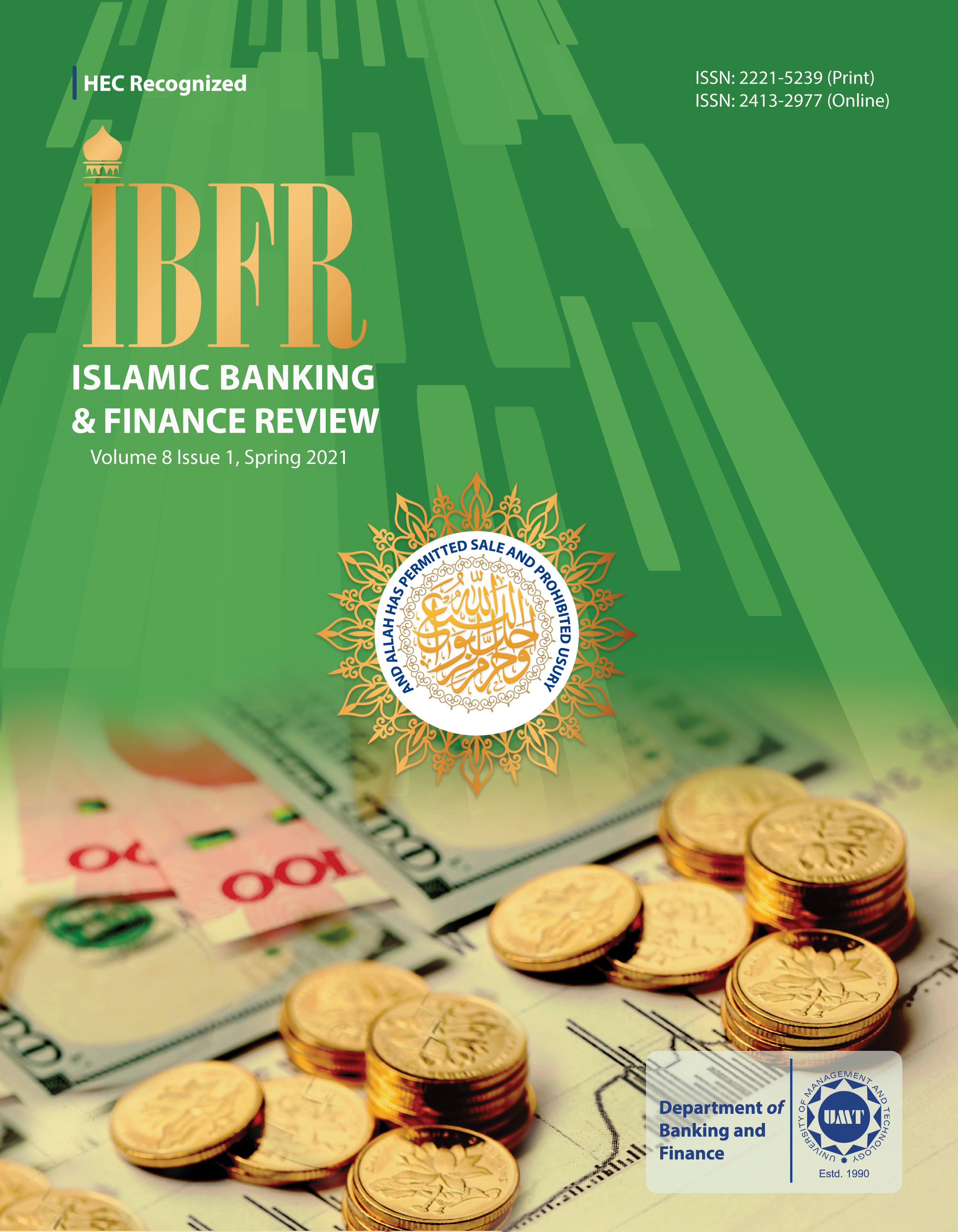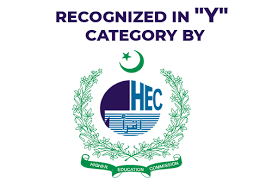Impact of COVID-19 on the Performance and Stability of Conventional and Islamic Banks in the GCC Region, Malaysia, and Pakistan
Abstract
 Abstract Views: 1650
Abstract Views: 1650
This study examines the impact of COVID-19 on the performance and stability of conventional and Islamic banks. The sample included all the 21 listed Islamic banks (IBs) and 44 listed conventional banks (CBs) from the GCC region, Malaysia, and Pakistan. Quarterly data of these banks covering the period January 2019 to June 2020 were obtained from their quarterly reports. Performance was measured by return on assets (ROA) and return on equity (ROE), while stability was measured by the Z-scores of these banks. Based on the previous literature, a better performance of IBs was expected because these banks are based on the participatory mode of financing instead of debt-based financing. However, the results of the current study showed a significant and negative impact of COVID-19 on the financial performance of both types of banks, suggesting that either type of banking was significantly affected during the pandemic. However, we did not find any significant evidence of the impact of COVID-19 on the stability of these banks.
Downloads
References
Al-Deehani, T. M., El-Sadi, H. M., & Al-Deehani, M. T. (2015). Performance of Islamic Banks and Conventional Banks before and during Economic Downturn. Investment Management and Financial Innovations 12, 238–50.
Alqahtani, F., & Mayes, D. G. (2018). Financial stability of Islamic banking and the global financial crisis: Evidence from the Gulf Cooperation Council. Economic Systems, 42(2), 346–360. https://doi.org/10.1016/j.ecosys. 2017.09.001 DOI: https://doi.org/10.1016/j.ecosys.2017.09.001
Alshammari, T. (2017). Performance differences between Islamic and Conventional Banking forms. Banks and Bank Systems, 12(3), 237–46. DOI: https://doi.org/10.21511/bbs.12(3-1).2017.08
Beck, T., Demirgüç-Kunt, A., & Merrouche, O. (2013). Islamic vs. conventional banking: Business model, efficiency and stability. Journal of Banking & Finance, 37(2), 433–447. https://doi.org/10.1016/j.jbankfin.2012.09.016 DOI: https://doi.org/10.1016/j.jbankfin.2012.09.016
Bagliano, F. C., & Morana, C. (2012). The Great Recession: US dynamics and spillovers to the world economy. Journal of Banking & Finance, 36(1), 1–13. DOI: https://doi.org/10.1016/j.jbankfin.2011.06.002
Bentolila, S., Jansen, M., & Jiménez, G. (2018). When credit dries up: Job losses in the great recession. Journal of the European Economic Association, 16(3), 650–695. https://doi.org/10.1093/jeea/jvx021 DOI: https://doi.org/10.1093/jeea/jvx021
Bezemer, D. J. (2011). The credit crisis and recession as a paradigm test. Journal of Economic Issues, 45(1), 1–18. https://doi.org/10.2753/JEI0021-3624450101 DOI: https://doi.org/10.2753/JEI0021-3624450101
Bourkhis, K., & Nabi, M. S. (2013). Islamic and conventional banks' soundness during the 2007–2008 financial crisis. Review of Financial Economics, 22(2), 68–77. https://doi.org/10.1016/j.rfe.2013.01.001 DOI: https://doi.org/10.1016/j.rfe.2013.01.001
Cerović, L., Suljić Nikolaj, S., & Maradin, D. (2017). Comparative analysis of conventional and Islamic banking: Importance of market regulation. Ekonomska Misao i Praksa, 26(1), 241–263.
Crafts, N., & Fearon, P. (2010). Lessons from the 1930s great depression. Oxford Review of Economic Policy, 26(3), 285–317.https://doi.org/10.1093/oxrep/ grq030 DOI: https://doi.org/10.1093/oxrep/grq030
Dybvig, P. H. (1983). An explicit bound on individual assets' deviations from APT pricing in a finite economy. Journal of Financial Economics, 12(4), 483–496.
https://doi.org/10.1016/0304-405X(83)90045-4 DOI: https://doi.org/10.1016/0304-405X(83)90045-4
El-Erian, M. (2020). The Coming Coronavirus Recession and the Uncharted Territory Beyond. Foreign Affairs, Media Report. https://www.foreignaffairs.com/articles/2020-0317/coming-coronavirus-recession
Farooq, M., & Zaheer, S. (2015). Are Islamic banks more resilient during financial panics? Pacific Economic Review, 20(1), 101–124. DOI: https://doi.org/10.1111/1468-0106.12096
Gaiotti, E. (2013). Credit availability and investment: Lessons from the “great recession”. European Economic Review, 59, 212–227. https://doi.org/10.1016/ j.euroecorev.2012.12.007 DOI: https://doi.org/10.1016/j.euroecorev.2012.12.007
Hasan, M., & Dridi, J. (2011). The effects of the global crisis on Islamic and conventional banks: A comparative study. Journal of International Commerce, Economics and Policy, 2(02), 163–200. https://doi.org/10.1142/ S1793993311000270 DOI: https://doi.org/10.1142/S1793993311000270
Jagannathan, R., Kapoor, M., & Schaumburg, E. (2013). Causes of the great recession of 2007–2009: The financial crisis was the symptom not the disease. Journal of Financial Intermediation, 22(1), 4–29. https://doi.org/10.1016/ j.jfi.2012.06.002 DOI: https://doi.org/10.1016/j.jfi.2012.06.002
Khaskhelly, A. Z., (2015). Comparative Analysis of Performance of Islamic Vis a Vis Conventional Banking of Pakistan during Global Financial Crisis 2007–2010. Journal of Islamic Banking and Finance, 32, 45–55.
Larry Elliot, L. (2020). Prepare for the coronavirus global recession. The Guardian. Media report. Available at: https://www.theguardian.com/business/2020/ mar/15/prepare-for-the-coronavirusglobal-recession
Mian, A., & Sufi, A. (2010). The great recession: Lessons from microeconomic data. American Economic Review, 100(2), 51–56. DOI: https://doi.org/10.1257/aer.100.2.51
Mollah, S., Hassan, M. K., Al Farooque, O., & Mobarek, A. (2017). The governance, risk-taking, and performance of Islamic banks. Journal of Financial Services Research, 51(2), 195–219. https://doi.org/110.1007/ s10693-016-0245-2 DOI: https://doi.org/10.1007/s10693-016-0245-2
Ouerghi, F. (2014). Are Islamic banks more resilient to global financial crisis than conventional banks? Asian Economic and Financial Review, 4(7), 941–955.
Ozili, P. K., & Arun, T. (2020). Spillover of COVID-19: impact on the Global Economy. Available at SSRN 3562570. DOI: https://doi.org/10.2139/ssrn.3562570
Parashar, S. P. (2010). How did Islamic banks do during global financial crisis? Banks and Bank Systems, 5(4), 54–62.
Rajhi, W., & Hassairi, S. A. (2013). Islamic banks and financial stability: a comparative empirical analysis between MENA and Southeast Asian countries. Région ET développement, 37(1), 1–31. DOI: https://doi.org/10.2139/ssrn.2010126
Stiglitz, J. E. (2010). Interpreting the Causes of the Great Recession of 2008. Financial System and Macroeconomic Resilience: Revisited, 53, 297–361.
Zineldin, M. (1990). The economics of money and banking: A theoretical and empirical study of Islamic interest-free banking (Doctoral dissertation) Almqvist & Wiksell International.
Copyright (c) 2021 Qazi Yasir Arafat, Abdul Rashid, Qazi Waseem Jan

This work is licensed under a Creative Commons Attribution 4.0 International License.
Authors retain copyright and grant the journal right of first publication with the work simultaneously licensed under a Creative Commons Attribution (CC-BY) 4.0 License that allows others to share the work with an acknowledgement of the work’s authorship and initial publication in this journal.












